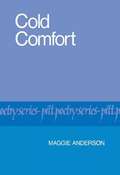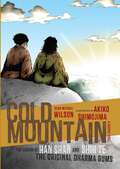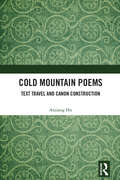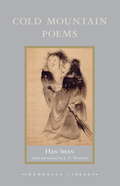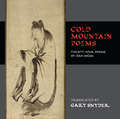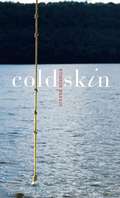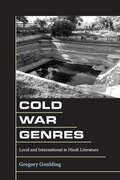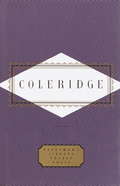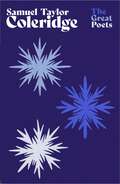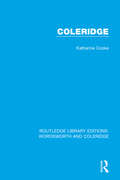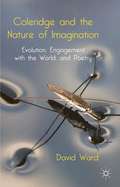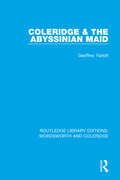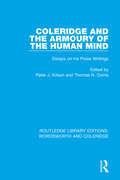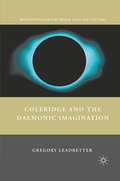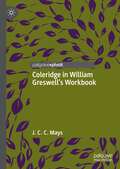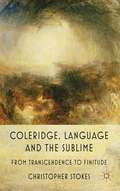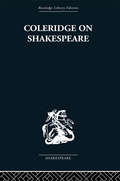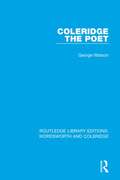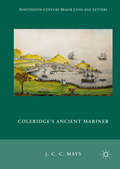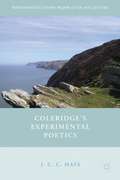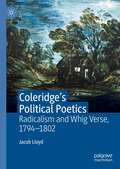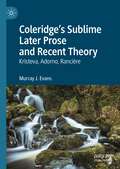- Table View
- List View
Cold Comfort
by Maggie AndersonPoems by Anderson about country life, photographs by Walker Evans, vegetables, etc.
Cold Mountain: The Legend of Han Shan and Shih Te, the Original Dharma Bums
by Sean Michael WilsonHere is a graphic novel portrait of the wild antics and legendary poetry of two of China’s greatest poets. Han Shan (known as "Cold Mountain") and Shih Te lived during the Tang dynasty (618–906 C.E.) and were critics of authority (both secular and religious) and champions of social justice. They left their poetry on tree trunks and rocks, and they were also reportedly monastics, drunks, cave dwellers, immortals, and many other unconventional and wondrous things. There is much delightful uncertainty about this "Laughing Pair"—including whether or not they actually even existed. What is known is that the poetry attributed to them was hugely influential in both China and Japan, and to the Beat writers in the United States during the 1950s and ’60s.Acclaimed manga creator Sean Michael Wilson, along with illustrator Akiko Shimojima and expert translator J. P. Seaton, brings these renegade poets to life, revealing their humor and wackiness and also their penetrating insights into the human condition.
Cold Mountain Poems: Text Travel and Canon Construction
by Anjiang HuThis book unveils the legendary life and the mystic poems of the iconic Chinese Tang poet Han-shan (known by his pen name “Cold Mountain”) and investigates the dissemination and reception of the Cold Mountain Poems (CMPs) attributed to him. Han-shan and the CMPs are amongst the most legendary literary landscapes and cultural memories in the history of world scholarly exchange. The maniac poet recluse hidden in the Cold Mountains, the delicate poetic realms of Confucianism, Buddhism, Zen and Taoism contained in the Cold Mountain Poems, and the incredible pervasiveness of its text travel and canon construction worldwide, as well as the profound impact of CMPs on comparative literature, world literature and Chinese studies, provide the perfect lens to learn about Chinese language, literature, culture and society. This book is thus intended to investigate CMPs in a coherent global context. Considering the vertical studies of the Chinese literature polysystem, it highlights the horizontal influence of CMPs, literarily or non-literarily. Furthermore, it addresses the making and developing of the Han-shan phenomenon and its implications for translation studies, travel writing, canon construction and literary historiography. This book is for scholars, researchers and students in literary history and East Asian Studies focusing on Chinese literature and culture and those interested in the history of poetry in general.
Cold Mountain Poems: Zen Poems of Han Shan, Shih Te, and Wang Fan-chih
by J. P. Seaton Han ShanThe incomparable poetry of Han Shan (Cold Mountain) and his sidekick Shih Te, the rebel poets who became icons of Chinese poetry and Zen, has long captured the imagination of poetry lovers and Zen aficionados. Popularized in the West by Beat Generation writers Gary Snyder and Jack Kerouac, these legendary T'ang era (618-907) figures are portrayed as the laughing, ragged pair who left their poetry on stones, trees, farmhouses, and the walls of the monasteries they visited. Their poetry expressed in the simplest verse but in a completely new tone, the voice of ordinary people. Here premier translator J. P. Seaton takes a fresh look at these captivating poets, along with Wang Fan-chih, another "outsider" poet who lived a couple centuries later and who captured the poverty and gritty day-to-day reality of the common people of his time. Seaton's comprehensive introduction and notes throughout give a fascinating context to this vibrant collection.
Cold Mountain Poems
by Gary SnyderIn 1953, Gary Snyder returned to the Bay Area and, at age 23, enrolled in graduate school at the University of California, Berkeley, to study Asian languages and culture. He intensified his study of Chinese and Japanese, and taking up the challenge of one of his professors, Chen Shih-hsiang, he began to work on translating a largely unknown poet by the name of Han Shan, a writer with whom the professor thought Snyder might feel a special affinity. The results were magical. As Patrick Murphy noted, "These poems are something more than translations precisely because Snyder renders them as a melding of Han Shan's Chinese Ch'an Buddhist mountain spirit trickster mentality and Snyder's own mountain wilderness meditation and labor activities." <P> The suite of 24 poems was published in the 1958 issue of The Evergreen Review, and the career of one of America's greatest poets was launched.In 1972, Press-22 issued a beautiful edition of these poems written out by hand in italic by Michael McPherson. We are doing a new augments edition based on the old, with a new design, a preface by Lu Ch'iu-yin, and an afterword by Mr. Snyder where he discusses how he came to this work and what it meant to his development as a writer and Buddhist.<P> On May 11, 2012, for the Stronach Memorial Lecture at The University of California, more than fifty years after his days there as a student, Snyder offered a public lecture reflecting on Chinese poetry, Han Shan, and his continuing work as a poet and translator. This remarkable occasion was recorded and we are including a CD of it in our edition, making this the most definitive edition of Cold Mountain Poems ever published.<P> Advisory: Bookshare has learned that this book offers only partial accessibility. We have kept it in the collection because it is useful for some of our members. To explore further access options with us, please contact us through the Book Quality link on the right sidebar. Benetech is actively working on projects to improve accessibility issues such as these.
Cold Skin
by Steven HerrickIn a rural Australian coal mining town shortly after World War II, teenaged Eddie makes a startling discovery when he investigates the murder of a local high school girl.
Cold War Genres: Local and International in Hindi Literature
by Gregory GouldingCold War Genres explores post-independence Hindi literature, framing it within the sociopolitical backdrop of Nehruvian India during the early Cold War. The book underscores the pivotal role of Hindi's claims to be a national language following independence, which fostered a unique moment of literary innovation. Central to its narrative is the work of Gajanan Madhav Muktibodh, a pivotal figure in modern South Asian literature. Using Muktibodh's poetry, criticism, and fiction as a primary example, the book shows how literary form shapes a response to the internal contradictions of 1950s India, one that must be read in light of both the antinomies of Hindi literature and North India as well as the aesthetic debates and emerging ideas of global space during this time. Cold War Genres therefore functions as a lens to evaluate questions of genre and form shared by a range of literary cultures in the mid-twentieth-century decolonizing world. This book features extensive translations from Muktibodh's poetry and prose, including full translations of two poems "Brahmarākṣas" (The Brahman Demon) and "Aṃdhere meṃ" (In the Dark).
Coleridge: Poems
by Samuel Taylor ColeridgeSamuel Taylor Coleridge (1772-1834) was the master impresario of English Romanticism -- an enormously erudite and tireless critic, lecturer, and polemicist who almost single-handedly created the intellectual climate in which the Romantic movement was received and understood. He was also, in poems such as 'The Rime of the Ancient Mariner,' 'Christabel,' and 'Kubla Khan.' the most uncanny, surreal, and startling of the great English poets.
Coleridge: Everyman's Poetry (Everyman's Poetry Ser. #Vol. 18)
by Samuel Taylor Coleridge John BeerThe best of Samuel Taylor Coleridge's poems in a beautiful new gift editionSamuel Taylor Coleridge (1772-1834) was educated at Christ's Hospital, London and Jesus College, Cambridge. Close collaboration with Wordsworth resulted in joint production of the volume Lyrical Ballads in 1798, which contained Coleridge's 'The Rime of the Ancient Mariner', signposting the Romantic movement. After wintering in Germany in 1797-8 he settled in the Lake District, where he wrote the 'Letter' that turned into 'Dejection: An Ode' (1802). In later years Coleridge turned increasingly to prose, covering philosophical, political, religious and critical subjects, although new poems continued to appear in most years until his death.
Coleridge (RLE: Wordsworth and Coleridge #3)
by Katharine CookeFirst published in 1979, this book provides thorough a guide through Coleridge’s diverse body of work, looking not just his poetry but also his literary criticism and theories, plays, political journalism and theory, and writings on religion and philosophy. The author is careful to avoid emphasising one aspect of his work over another and consequently the whole emerges as a richer, more complete body of thought — less esoteric and more concerned with the world. It challenges the notion of the ‘damaged archangel’, showing he was a successful playwright, long-standing contributor to one of the foremost papers of the day and a literary figure of note in touch with leading thinkers and writers.
Coleridge And The Nature Of Imagination
by David WardExamining a range of Coleridge's writings, this book uses recent scientific research to understand how we have evolved to make mental representations of the counterfactual, how such transformative essays in Imagination have enabled humans to survive, to prosper and to express themselves in the sciences, the arts and particularly in poetry.
Coleridge and the Abyssinian Maid (RLE: Wordsworth and Coleridge #14)
by Geoffrey YarlottFirst published in 1967, this book seeks to show the causes which led to Coleridge’s breakdown in 1802 and to indicate how his views on poetry changed as a result of it. The approach is selective in that it only focuses on one part of Coleridge’s life (roughly 1793-1810); however the author attempts to relate a number of different areas of his activity and to trace his emotional and moral development more closely than might be possible in a full-scale biography. The account of Coleridge’s life ends in 1810, when his relationship with the two key figures in his life Asra and Wordsworth had ruptured, as this reflected which of Coleridge’s Notebooks were available at the time.
Coleridge and the Armoury of the Human Mind: Essays on his Prose Writings (RLE: Wordsworth and Coleridge #7)
by Thomas N. Corns Peter J. KitsonFirst published in 1991, this book collects a broad array of path-finding scholarship by specialists in Coleridge and Romantic literature on the subject of his prose. They range from broad appraisals of Coleridge’s own critical practises; demonstrations of the fecundity of his autobiography, the Biographia Literaria, for contemporaries; the effect of Milton and the radical polemicists of the English Civil War on Coleridge’s early political and religious dissent; and the influence of the Hebrew prophetic tradition in his move away from the conjectural millenarianism of his youth towards the interpretation of Prophecy and a symbolic narrative.
Coleridge and the Daemonic Imagination (Nineteenth-Century Major Lives and Letters)
by Gregory LeadbetterThrough politics, religion and his relationship with Wordsworth, the book builds to a new interpretation of the poems where Coleridge's daemonic imagination produces its myths: The Ancient Mariner, Kubla Khan and Christabel . Re-reading the origins of Romanticism, Leadbetter reveals a Coleridge at once more familiar and more strange.
Coleridge and the Philosophy of Poetic Form
by Ewan James JonesEwan James Jones argues that Coleridge engaged most significantly with philosophy not through systematic argument, but in verse. Jones carries this argument through a series of sustained close readings, both of canonical texts such as Christabel and The Rime of the Ancient Mariner, and also of less familiar verse, such as Limbo. Such work shows that the essential elements of poetic expression - a poem's metre, rhythm, rhyme and other such formal features - enabled Coleridge to think in an original and distinctive manner, which his systematic philosophy impeded. Attentiveness to such formal features, which has for some time been overlooked in Coleridge scholarship, permits a rethinking of the relationship between eighteenth-century verse and philosophy more broadly, as it engages with issues including affect, materiality and self-identity. Coleridge's poetic thinking, Jones argues, both consolidates and radicalises the current literary critical rediscovery of form.
Coleridge: Everyman's Poetry
by Samuel Taylor ColeridgeThe best of Samuel Taylor Coleridge's poems in a beautiful new gift editionSamuel Taylor Coleridge (1772-1834) was educated at Christ's Hospital, London and Jesus College, Cambridge. Close collaboration with Wordsworth resulted in joint production of the volume Lyrical Ballads in 1798, which contained Coleridge's 'The Rime of the Ancient Mariner', signposting the Romantic movement. After wintering in Germany in 1797-8 he settled in the Lake District, where he wrote the 'Letter' that turned into 'Dejection: An Ode' (1802). In later years Coleridge turned increasingly to prose, covering philosophical, political, religious and critical subjects, although new poems continued to appear in most years until his death.
Coleridge in William Greswell’s Workbook
by J. C. MaysThis book provides a critical and biographical account of the fascinating hand-made book of rector William Greswell (1848-1923), in which he assembled British and American reviews and accounts of the Romantic poet, critic, philosopher, and religious thinker Samuel Taylor Coleridge (1772-1834). J.C.C. Mays re-evaluates Coleridge’s nineteenth-century reputation through the lens provided by Greswell’s workbook. Mays demonstrates how Coleridge is one of the most complicated and influential religious thinkers of the nineteenth century, whose “religious musings” (most prominently as published in Aids to Reflection and On the Constitution of the Church and State, but also in posthumous collections such as Confessions of an Inquiring Spirit) cast a long shadow over religious thinking in nineteenth-century England and America. Although Greswell was but one of Coleridge’s many readers in the nineteenth century, his engagement with Coleridge’s writings was noteworthy for the sheer mass of the materials he assembled, and the breadth of the Coleridge he depicts. Greswell’s Coleridge is a Coleridge in whom all Coleridgeans will be interested.
Coleridge, Language and the Sublime
by Christopher StokesTraversing the themes of language, terror and representation, this is the first study to engage Coleridge through the sublime, showing him to have a compelling position in an ongoing conversation about finitude. Drawing on close readings of both his poetry and prose, it depicts Coleridge as a thinker of 'the limit' with contemporary force.
Coleridge on Shakespeare: The text of the lectures of 1811-12 (Monographs)
by R. A. FoakesFirst published in 1971. The only substantial text of a series of lectures on Shakespeare by S T Coleridge is that provided by J P Collier's Seven Lectures on Shakespeare and Milton (1856). His text of these important lectures given by Coleridge in 1811-12 has been the basis of all modern editions. This edition is based on hitherto unpublished transcripts of the lectures made by Collier when, as a young man, he attended Coleridge's lectures. R A Foakes' introduction and appendices demonstrate the extent to which Collier revised and altered Coleridge's words for the edition he published forty-five years later. This volume therefore provides a much more authoritative text of Coleridge's most important Shakespeare lectures.
Coleridge the Poet (RLE: Wordsworth and Coleridge #11)
by George WatsonFirst published in 1966. Despite the intense interest in Coleridge in the twentieth century, this book represents the first study of Coleridge’s poetry to be published in Britain. It is also the first to be based upon the conclusion that Coleridge’s greatness as a poet is a matter of achievement rather than aspiration and to argue that his literary career was nearly half a century long, consisting of more than just well-known texts like The Ancient Mariner and Kubla Khan. The author argues the formality of the romantic achievement and its success in creating whole and fully realised poems in the established literary kinds.
Coleridge's Ancient Mariner (Nineteenth-Century Major Lives and Letters)
by J. C. C. MaysThis is the first book-length study to read the "Ancient Mariner" as "poetry," in Coleridge's own particular sense of the word. Coleridge's complicated relationship with the "Mariner" as an experimental poem lies in its origin as a joint project with Wordsworth. J. C. C. Mays traces the changes in the several versions published in Coleridge's lifetime and shows how Wordsworth's troubled reaction to the poem influenced its subsequent interpretation. This is also the first book to situate the "Mariner" in the context of the entirety of Coleridge's prose and verse, now available in the Bollingen Collected edition and Notebooks; that is, not only in relation to other poems like "The Ballad of the Dark Ladiè" and "Alice du Clós," but also to ideas in his literary criticism (especially Biographia Literaria), philosophy, and theology. Using a combination of close reading and broad historical considerations, reception theory, and book history, Mays surveys the poem's continuing life in illustrated editions and educational textbooks; its passage through the vicissitudes of New Criticism and critical theory; and, in a final chapter, its surprising affinities with some experimental poems of the present time.
Coleridge's Dejection Ode (Nineteenth-Century Major Lives and Letters)
by J.C.C. MaysColeridge's Dejection Ode completes J.C.C. Mays’ analysis of Coleridge’s poetry, following Coleridge’s Ancient Mariner (Palgrave 2016) and Coleridge’s Experimental Poetics (Palgrave 2013). "Dejection: An Ode" stands alone in Coleridge's oeuvre: written at a time of personal crisis, it reaches far back and deeply into his thinking in an attempt to find a poematic solution to ideas and problems he had mulled over for a long time. Mays reveals how the poem also marks the opening of the second half of Coleridge's career as both poet and thinker. In three central chapters Mays examines the new style that evolved in the process of writing the Ode: the technical means of metrics, rhyme and grammar; language and allusion; and symbol and structure. He recounts the complex, sometimes controversial critical history of the Ode, and suggests an editorial solution to the problem created by the Letter to Sara Hutchinson; re-evaluates the position of Wordsworth in the poem apropos the political statement it makes; clarifies the distinction between the views on Imagination expressed and those contained in Biographia Literaria; and traces the links of the concept "dejection" as it underpins Coleridge's late poems.
Coleridge’s Experimental Poetics
by J. C. C. MaysColeridge has been perceived as the youthful author of a few brilliant poems. Coleridge's Experimental Poetics argues that his poetry is actually a continuous process of experimentation and provides a new perspective on both familiar and unfamiliar poems, as well as the relation between Coleridge's poetry and philosophical thinking. Taking into account the 300 new poems published in 2001, this is the first complete poetic analysis of Coleridge's work.
Coleridge's Political Poetics: Radicalism and Whig Verse 1794 - 1802
by Jacob LloydThis book considers Samuel Taylor Coleridge’s engagement with ‘Whig poetry’: a tradition of verse from the eighteenth century which celebrated the political and constitutional arrangements of Britain as guaranteeing liberty. It argues that, during the 1790s, Coleridge was able to articulate radical ideas under the cover of widely accepted principles through his references to this poetry. He positioned his poetry within a mainstream discourse, even as he favoured radical social change. Jacob Lloyd argues that the poets Mark Akenside, William Lisle Bowles, and William Cowper each provided Coleridge with a kind of Whig poetics to which he responded. When these references are understood, much of Coleridge’s work which seems purely personal or imaginative gains a political dimension. In addition, Lloyd reassess Coleridge’s relationship with Thomas Percy’s Reliques of Ancient English Poetry, to provide an original, political reading of ‘The Rime of the Ancyent Marinere’. This book revises our understanding of the political and poetic development of a major poet and, in doing so, provides a new model for the origins of British Romanticism more broadly
Coleridge’s Sublime Later Prose and Recent Theory: Kristeva, Adorno, Rancière
by Murray J. EvansThis book explores the sublime in Samuel Taylor Coleridge’s later major prose in relation to more recent theories of the sublime. Building on the author’s previous monograph Sublime Coleridge: The Opus Maximum, this study focuses on sublime theory and discourse in Coleridge’s other major prose texts of the 1820s: Confessions of an Inquiring Spirit (wr. 1824), Aids to Reflection (1825), and On the Constitution of the Church and State (1829). This book thus ponders the constellations of aesthetics, literature, religion, and politics in the sublime theory and practice of this central Romantic author and three of his important successors: Julia Kristeva, Theodor Adorno, and Jacques Rancière.
